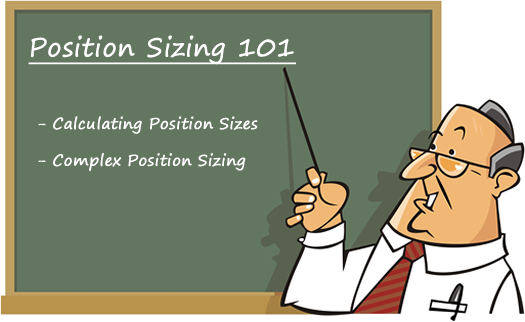
What's Your Maximum Loss?
However
- Being confident does not guarantee that the markets will behave
- Overconfidence leads to ignoring risk management
- Big size can produce devastating losses
- The Risk of Ruin increases exponentially as trade size increases
- Preventing big losses represents the successful trader’s path to wealth
Most beginners are shy about making a big monetary commitment and usually start trading with a small investment. When buying options, they set a maximum dollar amount to be invested. It is obvious that the cost of the options represents the most that can be lost.
However, when adopting any of the ‘income generating’ strategies, even though the trader may know the results of the worst case scenario, it is often difficult to recognize that such losses do occur. Why is that? I believe it is the result of a natural optimism that accompanies the discovery of options as an investment tool. The conservative trader begins with one-lots. She progresses as her confidence and experience grow.
The aggressive trader, who does not (yet) understand how important risk management is to his future success, may begin trading positions that are large enough to destroy 25 to 50% of his account value in a single trade.
Let’s take a detailed look at how a trader – especially a new trader – is supposed to determine an appropriate trade size.
Hi Mark,
I saw your webinar “Can you earn a steady income with Options – The Career Plan.”
You discuss a $50k account and suggest that $40k of margin be used, with $10k left for adjustments or other trades.
In that $40k you discuss that if we are doing 10-point credit spreads, then the margin required is $1k per spread – so you can take a max of 40 IC’s – so that means if one is doing trades expiring in 2 different months, then that’s 20 IC’s for each expiry.
What's the optimal Trade Size?
So in short, with a $50k account, a good plan would be to take 20 IC’s in each of those 2 expiring months.
‘Good plan’? That depends on the trader.
But, yes, that is what I recommend as the MAXIMUM trade size. It is ALWAYS acceptable to trade less size.
It is always safer to keep more money on the sidelines for repairing trades gone awry.
One of the worst feelings of helplessness occurs when you are losing money, the market is moving against your position, you see an excellent trade that reduces risk and solves your temporary problem – only to discover that the trade increases the margin requirement and you lack the funds to make the trade.
I confess that I did not emphasize that the plan I suggested in the video represents the MAXIMUM trade size. I do not want anyone to believe that an inexperienced trader can handle 40 iron condors when the account size is $50,000. Many experienced traders would find that trade size to be far outside their comfort zones.

If you are not a member yet, you can join our forum discussions for answers to all your options questions.
Any trader’s individual skill and experience play a large role in determining how much cash you want to hold as a cushion.
We must recognize that 20-lots of a 10-point iron condor may not seem too big to handle. And most of the time that is true. However, it is possible to lose as much as $700 or $800 per spread. That unlikely, but possible, loss of $14k to $16k is far too much for a $50k account.
Are You An Experienced Trader?
The experienced trader; the disciplined trader; the trader who knows that he/she does have the will power to do what is necessary and take appropriate action to insure survival – even it means locking in a big loss; that trader can handle positions of this size.
When I refer to a trader who has the will power – I am referring to someone who has done it – more than once. It is far too easy for the less-experienced trader to look at a $5,000 loss and refuse to accept the fact that a given trade is not going to work. The trader who hates losing that much and wants ‘his/her money back’ is not going to be a successful trader. When money has been lost, it is no longer your money. It belongs to someone else. That traders JOB is to salvage his account by fixing the problem. That is accomplished by exiting the trade, reducing size, or making a risk-reducing position adjustment.
If you do not know FOR A FACT that you will have the courage – and it does take courage to face reality – that you will act to prevent larger losses and that you will not just close your eyes and hope that the market reverses direction – then you are not yet ready to trade bigger position size. Have patience, gain experience, and trade far below the recommended maximum.
I repeat: I did not emphasize those points when making that video.
The video discussion was about the minimum amount of spare cash an iron condor trader should keep available. More cash increases the probability that you be able to handle any crisis and survive for the long term.
I do understand that you will probably never lose the maximum, because you would adjust and reduce risk. However, are you positive that you would not panic or refuse to act? Do you really want to bet your entire trading account on that possibility?
We recognize that the maximum loss is possible if the market crashes, and we do want to think in terms of a worst-case scenario when looking at risk. But one note: If the market crashes, IV will be sky high. Those very deep ITM put spreads will not be trading near $10. You would be able to cover at a price of $7 to $9. You may not want to do that, hoping for a reversal, but the maximum loss would not occur right away, unless it is expiration day.
The way I have read about managing risk is to decide how much you are going to risk on each trade. So let’s say I had a $50k and I decide I will not risk more than 4% per trade – so 4% of 50k is $2k. In the above scenario where the risk per IC was $820 I would only do a maximum of 2 or 3 IC’s ($2k divided by $820).
Could you advise the pros and cons of each – surely the 20 IC’s will provide much higher return.
Yes, the cash returns could be very high. But more than that, the loss potential is also high. Too high in my opinion.
As far as risking 1, 2, or 4% of the account value on a trade, that is not for traders who do as we do. That is for the day- or swing-trader or who buys stocks (futures etc). We can take a little more risk per trade because the chances of losing the maximum are very small. That is not true for the day trader. That day trader (or investor) could establish a stop loss at that 2% or 4% level. Losing that maximum is not a rare situation.
Similarly, an investor who follows your suggested rule could own more than 20 simultaneous investments. That works for the longer-term investor who does not have to make moment-to-moment trade decisions.
We, and our positions, do not allow for convenient stop loss orders (for many reasons). But that does not mean we should go as far as putting 16k (32% of the account) at risk for any trade. We need a more reasonable limit.
I am comfortable telling you that if you own two 10-lot iron condors – that is reasonable trade size despite the possibility of losing $8k on each spread, IF AND ONLY IF
- You are comfortable with that size
- You have experience making adjustments and taking losses
You are not nervous with that size (within comfort zone)
If it is early in your career, I would be more comfortable suggesting that you trade two three-lots positions.
Related articles:
Trading An Iron Condor: The Basics
Trade Iron Condors Like Never Before
Why Iron Condors are NOT an ATM machine
Why You Should Not Ignore Negative Gamma
Are You Ready For The Learning Curve?
How Position Sizing Impacts Your Returns
Want to learn how to reduce risk and put probabilities in your favor? We discuss how to do it on our forum.



There are no comments to display.
Join the conversation
You can post now and register later. If you have an account, sign in now to post with your account.
Note: Your post will require moderator approval before it will be visible.